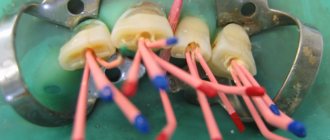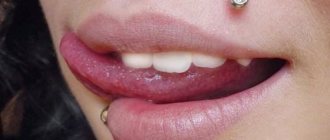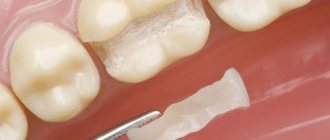The word “ gutta-percha ” has become a household word among the people as a definition of great flexibility and elasticity, both in the literal and figurative sense. But dentists have their own thoughts on this matter, so let’s look at it in order:
If you ask your friends to name the first dental procedures that come to mind, they will most likely be fillings, crowns and root canals. Of these three, root canal is the treatment that people may know the least about unless they are lucky enough to have it. Even those who have had successful experience with this treatment may not have heard of gutta-percha: the substance used during this procedure.
From a scientific point of view
What is the meaning of the word "gutta-percha"? From a scientific point of view, this material was classified in 1843 and classified as a useful natural thermoplastic. In the second half of the 19th century, gutta percha was used for a variety of domestic and industrial purposes.
In particular, this material was needed as an insulating substance for submarine telegraph cables. Long before gutta percha was introduced into the Western world, it was used in a less processed form by the natives of the Malaysian archipelago to make knife handles, walking canes and other purposes.
The first European to discover this material was John Tradescant, who discovered it in the Far East in 1656. He called it "Mather's forest." Dr. William Montgomery, a medical officer in the Indian Service, introduced gutta-percha into practical use in the West. He was the first to recognize the potential of this material in medicine, and in 1843 he was awarded the gold medal of the Royal Society of Arts in London.
Gutta-percha tree
In Malaysia, the tree is known as "taban" and people there traditionally used the hardened sap ("hanah") to make items such as molded handles for tools and knives. This natural latex, also called gutta-percha, is a very valuable product.
Palaquium gutta trees grow 5-30 m in height and are usually up to 1.5 m in diameter. The leaves are evergreen, alternate or spirally arranged, simple, entire, about 8-25 cm long each. They are glossy green above and often yellow or bluish below.
The flowers appear in small clusters along the stems, each flower having a white corolla with four to seven (mostly six) sharp lobes. The fruit is an ovoid berry 3-7 cm in diameter, containing from one to four seeds. In many species it is edible.
In Australia, gutta-percha is the common name specifically used for the tree Excoecaria parvifolia, which produces an aromatic, heavy, dark brown wood. It is also called "northern birch". This particular species is not related to the genus Palaquium.
Description[edit]
Gutta -percha tree Palaquium gutta
have a height of 5–30 meters (20–100 ft) and up to 1 m (3 ft) in trunk diameter. The leaves are evergreen, alternate or spirally arranged, simple, entire, 8–25 cm (3–10 in) long, glossy green above and often yellow or glaucous below. The flowers are produced in small clusters along the stems, each flower having a white corolla with four to seven (usually six) sharp petals. The fruit is a 3–7 cm (1–3 in) ovoid berry containing one to four seeds; in many species the fruit is edible.
In Australia, gutta-percha is the common name specifically used for the spurge tree Excoecaria parvifolia
, which produces aromatic heavy wood of a dark brown color.
From a chemical point of view
What does gutta-percha mean? In the literal sense, it is made from gutta-percha. What kind of meterial is this from a chemical point of view? Its structure is a latex elastomer or a polymer made of isoprene or polyisoprene. While latex rubbers are amorphous in molecular structure, gutta-percha (transstructure) crystallizes, resulting in a stiffer consistency. Gutta-percha is an isoprene polymer that is soft when heated and can be easily cast into a variety of shapes that are precisely detailed.
Chemistry[edit]
Chemical structure of gutta-percha [1]
Chemically, gutta-percha is a polyterpene, a polymer of isoprene, or polyisoprene in particular (trans - 1,4-polyisoprene). The cis structure of polyisoprene is a common latex elastomer. While latex rubbers have an amorphous molecular structure, gutta-percha (trans-structure) crystallizes, resulting in a stiffer material. It exists in alpha and beta forms, with the alpha form being brittle at room temperature.
Use in dentistry
The same bioinertia that made gutta-percha useful for marine cables also came in handy for medical purposes, namely dentistry. This material is used in many surgical devices and in root therapy (obturation or filling the empty space within the root of a tooth after it has undergone endodontic therapy). Its physical and chemical properties, including inertness and biocompatibility, melting point, ductility and malleability, make it important in endodontics.
Ensures long tooth life
If you want to restore a tooth for a long time, then you will definitely need gutta-percha for this. They also like to use it in dentistry because it does not absorb liquid, repels it, and retains its properties throughout its entire service life. This allows the entire structure to serve for a long time and not collapse or dissolve under the influence of various factors.
Pins made of materials such as gutta-percha, in turn, also do not affect the microflora of the tooth cavity. On the one hand, this is a minus - the material does not have bactericidal properties, since it is neutral. But with high-quality treatment, with hermetically sealed canals, such a need should not arise.
Historical use
Being biologically inert and stable, this type of latex is a good electrical insulator with a high dielectric constant. Wood of many types is also valuable. The properties of gutta-percha were noticed by the Western world only in 1842, although the local Malay aborigines had been using it for many centuries. Allowing this liquid (juice) to evaporate and coagulate in the sun produces a rigid latex that can be flexible again when heated, but is not brittle, unlike rubber made before the discovery of vulcanization.
By 1845, telegraph wires insulated with gutta-percha were being produced in Great Britain. Latex served as an insulating material for early submarine telegraph cables, including the first transatlantic telegraph cable. Gutta-percha was especially suitable for this as it was not attacked by the marine plants or animals that had damaged previous submarine cables.
The material was the main component of Chatterton joint, used as an insulating sealant for telegraph and other electrical cables. Since 1930, polyethylene has replaced gutta-percha as an electrical insulator.
In the mid-19th century, gutta-percha was also used to make furniture, notably founded in 1847. When heated, the material could be molded into furniture, jewelry, or tableware. Some of these decorative Revival pieces were shown at the Great Exhibition in 1851 in Hyde Park, London.
Modern use
It was also used to make mourning jewelry because it was dark in color and could easily be molded into beads or other shapes. Pistol grips and shoulder pads were also made of gutta-percha, which gave them strength and durability. The guttie golf ball, which had a hard gutta-percha core, revolutionized the game.
This material remained the main industrial product in the twentieth century, but later began to be gradually replaced by superior synthetic materials. Despite its long history, gutta percha is still used today. Modern dentists continue to use it to fill root canals.
Application
It is used as an insulating material in the electrical and radio industries, in the chemical and shoe industries, as well as in dentistry as a material for obturation of root canals in the treatment of pulpitis and periodontitis (non-absorbable filler for filling root canals, root filling). In particular, drive belts, conveyor belts, various gaskets, chemically resistant containers, various adhesives, and stamps are also made from gutta-percha. In the past, it was also used as a type of rubber - in particular, it was a traditional material for the manufacture of golf balls for a long time.
"Gutta-percha": meaning
What is this concept? So, in the literal sense, gutta-percha is made from gutta-percha (natural rubber). In a figurative sense, this word has acquired a meaning associated with flexibility and elasticity. In relation to people, this definition began to be used and became a household name after D. V. Grigorovich wrote his sad story “The Gutta-percha Boy”.
This is a tragic story about a circus boy who was said to have no bones, he was so flexible and dexterous. From now on, people who are called gutta-percha are athletes with good stretching. It is achieved through long training. The gutta-percha woman is a gymnast who can do incredible things with her body.
Gutta-percha gait
What does gutta-percha mean? This word is now quite fashionable and in youth slang means flexible, beautiful, graceful. If we recall the words from the song of the singer Bianca - “With a gutta-percha gait we walk into Iarfor (nightclub) ... “.
Here we mean not so much elastic and flexible, but soft, swaying and graceful. You can sometimes hear about a person that he or she is such a gutta-percha. It can mean flexible and sexy. Although in the past the term was associated with rubber and gymnasts, it is now also synonymous with sexuality.
What is gutta percha
The word “gutta-percha” itself means “piece of rubber” in Malay. It is not surprising, because the main property of gutta-percha is elasticity, which can be compared to rubber. Gutta-percha is extracted from the milky sap of special tree species (gutta-percha tree, etc.).
The chemical composition of gutta-percha is close to rubber.
The process of collecting gutta-percha is not much different from obtaining birch sap - the milky sap of the gutta-percha tree is collected by cutting the bark of trees and hanging ladles from them. The collected juice is evaporated until it thickens. The gutta-percha obtained in this way is purified under industrial conditions by washing in cold, then warm water, pressed in a heated state, and sticks or thin plates of light gray color are prepared. Gutta-percha is colored pink with carmine or black with bone soot (which is less common).
Ready-to-use gutta-percha plates are viscous and elastic. Under the influence of warm water (70°), gutta-percha becomes soft and acquires characteristic plasticity, easily taking any shape . But under the influence of sunlight, gutta-percha decomposes and loses its elasticity, so it should be stored in a dark, hermetically sealed container.
Excipients can significantly influence the physical properties of gutta-percha; for example, the addition of rubber makes gutta-percha more elastic, but the presence of chalk or zinc oxide makes it hard.











